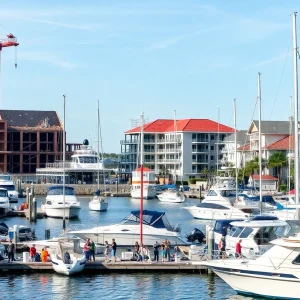Tropical Storm Rafael Forms in the Caribbean, Potential Threats to Gulf Coast
As of Monday afternoon, Tropical Storm Rafael has officially formed in the Caribbean Sea, stirring concerns about its possible impacts in the United States this weekend. The storm, which developed after traversing parts of the western Caribbean, is forecasted to strengthen into a hurricane by Tuesday as it moves over the warm waters of the northwest Caribbean, according to the National Hurricane Center.
Forecasts Indicate Uncertain Path
Reports indicate that Rafael is expected to hit Cuba on Wednesday and then move into the Gulf of Mexico. However, predicting its exact path and intensity along the U.S. Gulf Coast remains challenging at this stage. The National Hurricane Center stated, “It is too soon to determine what, if any, impacts Rafael could bring to portions of the northern Gulf Coast,” suggesting that continued monitoring is important for anyone from the Gulf Coast to northeastern Mexico.
In response to the storm’s formation, tropical alerts were issued for the Florida Keys, joining existing alerts in Cuba, Jamaica, and the Cayman Islands. The current forecasts show the storm’s center potentially reaching the U.S. Gulf Coast later this weekend, with possible landfall areas stretching anywhere from the Florida-Alabama border to Louisiana. However, these projections may change as the storm continues to develop and move through the Caribbean.
Forecast Models Show Variability
Two leading forecast models present significantly different future paths for Rafael once it enters the Gulf. One model suggests that Rafael will track northwest after making landfall in western Cuba and could hit somewhere between Louisiana and the Florida Panhandle. This scenario aligns with the hurricane center’s current projections. On the other hand, another model suggests that Rafael could take an unexpected sharp turn to the west in the Gulf, leading to potential landfall anywhere from northeastern Mexico to the western Gulf Coast.
These variations in forecast will greatly affect the flooding risk posed by the storm in Florida and the surrounding Southeast regions. Heavy rainfall from the storm is already enhancing current precipitation in these areas, indicating an increased flood threat in regions expecting rain later this week or weekend.
Record Storms This Season
Tropical Storm Rafael is notable as it marks the 17th named storm in the 2024 Atlantic hurricane season, and it is the 10th storm to form since September 24. This statistic sets a record for the number of named storms formed in the Atlantic during the period from September 24 to November 4, exceeding the previous record of nine set in 1950.
Typically, tropical activity winds down in November, but it remains possible to see storms during this month. According to hurricane expert Michael Lowry, landfalls in the U.S. are very rare during this time, as about 98% of named storms traditionally make landfall before November. The official Atlantic hurricane season concludes on November 30.
Immediate Impact on the Caribbean
While uncertainties loom regarding Rafael’s potential impact on the U.S., the storm poses clear threats to the Caribbean region this week. The core of the storm’s rain production was observed late Monday over the Caribbean Sea, while parts of both Hispaniola and Jamaica have already begun to experience heavy rain. The Cuban government elevated hurricane and tropical storm watches to warnings as of Monday night. The Cayman Islands are also currently under a hurricane warning.
Forecasts predict that Rafael could bring devastating rain and risks of flash flooding to several areas in the western Caribbean in the coming days. Total rainfall amounts of 3 to 6 inches are expected in Cuba and Jamaica, which could exacerbate the risks of mudslides, especially in Jamaica’s mountainous regions.
Effect on Local Conditions
As rain creeps into Florida and parts of the Southeast U.S. by mid to later this week, the lower and middle Florida Keys could see increased rainfall amounts ranging from 1 to 3 inches. The meteorological situation in Jamaica has prompted authorities to cancel all in-person classes for Tuesday, where strong winds and stormy weather have been reported.
As Rafael intensifies and moves closer, strong, potentially damaging winds are anticipated to reach Jamaica overnight Monday into Tuesday morning, with similar gusts expected in Cuba and the Florida Keys by Wednesday. The National Weather Service has warned that parts of the Cayman Islands could see storm surges reaching up to 3 feet, while western Cuba could experience dangerous surges of up to 9 feet.
Storm Precautions Urged
Officials advise residents in vulnerable areas to stay updated on the storm’s progression and to prepare for possible evacuations if conditions worsen. As always, safety remains the top priority as Tropical Storm Rafael continues to develop and move through the Caribbean.

























